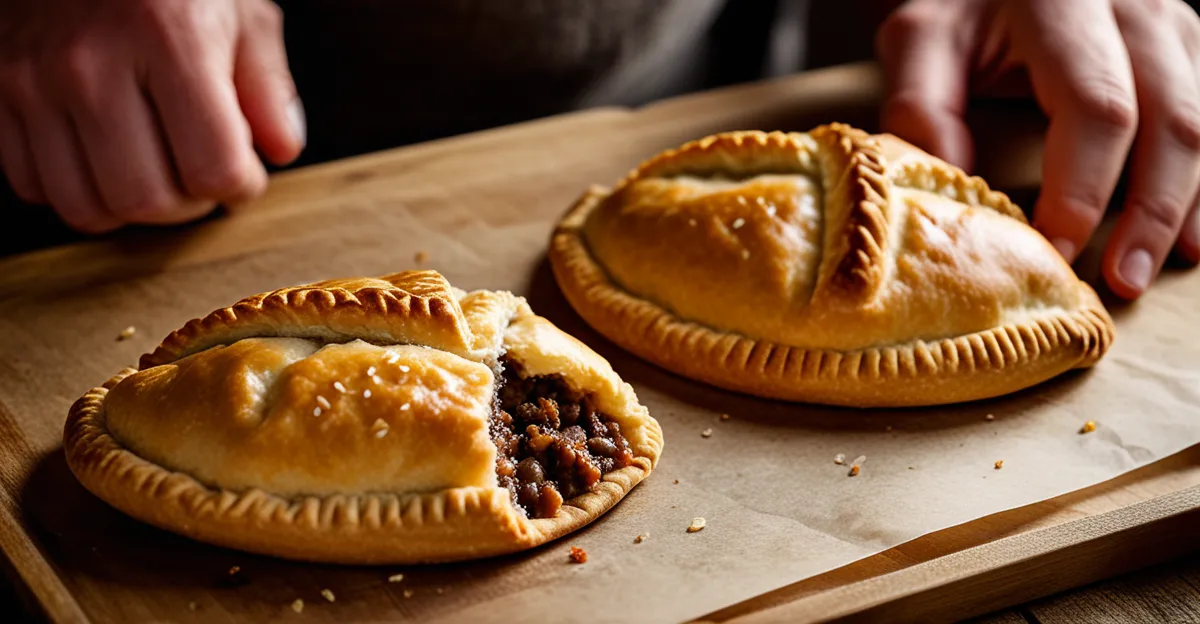Essential Ingredients and Tools for Traditional Cornish Pasty
Choosing the right Cornish pasty ingredients is crucial for capturing its authentic flavor. A traditional Cornish pasty filling includes four main components: beef, potato, swede, and onion. Using lean skirt or chuck beef ensures tenderness without excess fat. Potatoes should be waxy, like Maris Piper, for texture that holds up during baking. Swede adds a subtle sweetness and moisture balance, while onions provide a mild pungency that complements the meat.
Exact ingredient measurements often follow this ratio: roughly 200g each of beef and potato, and 100g each of swede and onion per pasty. Sourcing these fresh and of consistent quality enhances flavor and texture, so opt for local produce or trusted suppliers.
In terms of kitchen tools for baking Cornish pasties, a sturdy rolling pin and a heavy-duty baking tray are essential. A good pastry brush helps apply egg wash evenly, lending a golden crust. A sharp knife or pastry cutter ensures clean edges for folding and crimping. Finally, a cooling rack is useful to prevent sogginess after baking, maintaining the pasty’s characteristic crispness.
Preparing the Perfect Cornish Pasty Pastry
Achieving authentic Cornish pasty pastry begins with a simple shortcrust pastry recipe: blend 350g plain flour with 175g chilled diced butter until crumbly. Add a pinch of salt, then gradually mix in about 6 tablespoons of cold water to bind the dough. The key pastry making tips focus on handling the dough gently to avoid activating gluten, which can toughen the crust.
Once mixed, chill the pastry for at least 30 minutes. This resting period firms the fats and relaxes the flour, preventing shrinkage during baking. When rolling, use a floured surface and roll out evenly to about 3-4mm thickness—thin enough for crispness but sturdy to support the filling. Cornish pasty pastry needs strength for crimping and holding the filling without splitting.
Shaping the pastry into 20cm rounds is essential for traditional Cornish pasty size. To make handling easier, keep the dough cool throughout the process by chilling it if it becomes too soft. These steps ensure your pastry is both flavorful and robust, setting the foundation for a perfect pasty with that iconic crisp texture and flaky bite.
Crafting the Traditional Pasty Filling
Preparing an authentic Cornish pasty filling involves careful selection and preparation of its four essential components: beef, potato, swede, and onion. Begin by cutting the beef into small cubes, roughly 1cm pieces, to ensure even cooking and tenderness in the baking process. Use lean cuts like skirt or chuck to retain traditional flavor without excess fat.
Next, slice potatoes and swede into similar-sized cubes; waxy potatoes like Maris Piper prevent sogginess, while swede adds moisture and a subtle sweetness. Onions should be finely chopped to meld seamlessly with the other ingredients. This uniform sizing ensures the traditional Cornish pasty cooks evenly and maintains its distinctive texture.
Season the filling simply—typically just salt and freshly ground black pepper—to highlight the natural flavors. Avoid over-seasoning, as the pastry encases and intensifies the taste. Layer the filling on the pastry with beef on the bottom, then potato, swede, and finally onion on top. This method balances cooking times and flavor distribution, preserving the characteristic pasty texture and taste.
Attention to detail in preparing the Cornish pasty filling guarantees every bite delivers the classic, savory balance that defines this iconic pastry.
Assembling, Folding, and Crimping the Cornish Pasty
Mastering the Cornish pasty assembly is key to achieving its traditional shape and structure. Begin by placing the prepared filling—beef, potato, swede, and onion—in the center of a 20cm pastry round. Keep the ratio balanced: about 600g total filling per pasty ensures the pastry supports the contents without bursting.
When folding, carefully lift one side of the pastry over the filling, then fold the opposite edge to overlap. This technique protects the filling and creates a pocket that traps the juices. Sealing the edges firmly is critical to prevent leaks during baking.
The hallmark of the traditional Cornish pasty is its distinctive crimped edge. Starting at one end, pinch and fold the pastry rim inwards using your thumb and forefinger, gradually moving along the edge to create tight, even crimps. This not only secures the pasty but also offers a handle for eating without touching the filling.
Practicing the pasty folding steps ensures consistency and prevents splitting. If the pastry becomes soft during assembly, chilling briefly helps maintain its elasticity, making crimping easier. These steps together guarantee both a functional seal and the iconic Cornish shape.
Baking and Serving Your Homemade Cornish Pasty
Baking a traditional Cornish pasty requires careful temperature control to achieve a crisp, golden crust without overcooking the filling. Preheat your oven to around 190°C (375°F), placing the pasties on a heavy-duty baking tray to ensure even heat distribution. Bake for about 45 to 50 minutes; this timing allows the pastry to cook through while the beef, potato, swede, and onion inside reach optimal tenderness.
To check for doneness, the pastry should be golden-brown and firm to the touch, while the filling juices might slightly seep at the edges, signaling a perfectly sealed pasty. Avoid opening the oven too often, as this can lower the temperature and affect the baking process.
After baking, transfer the pasties to a cooling rack to prevent sogginess, preserving that desired crispy texture. Serving Cornish pasties warm enhances their rich, savory flavors, making them an ideal hearty meal or snack.
Leftovers can be stored in an airtight container and reheated in an oven at a moderate temperature to maintain crispness, rather than a microwave, which tends to soften the crust. With these baking and serving tips, your homemade Cornish pasty will deliver an authentic pasta experience every time.
Tips for Achieving Authentic Cornish Flavor at Home
To capture the authentic Cornish pasty flavor, prioritize sourcing fresh, high-quality ingredients. Using local or trusted suppliers for beef, potato, swede, and onion enhances the natural tastes that define this traditional dish. Selecting lean beef cuts like skirt or chuck and waxy potatoes like Maris Piper preserves the balance of texture and flavor crucial to a true Cornish pasty.
Avoid common mistakes such as over-seasoning the filling or rushing pastry preparation, which can compromise the classic taste and texture. Remember, the filling’s seasoning should be simple—mainly salt and black pepper—allowing the ingredient quality to shine. Similarly, handling the Cornish pasty pastry gently prevents toughness.
For those with dietary preferences, modifications can be made without losing authenticity. For example, substituting beef with a flavorful minced alternative while keeping the traditional vegetable mix can work, although maintaining original ingredient proportions preserves the flavor profile best.
Finally, patience during preparation and baking—respecting resting times for dough and precise oven temperatures—ensures the pasty develops that signature golden crisp crust and well-cooked filling. Following these Cornish baking tips will bring the iconic pasty experience reliably into your kitchen.











